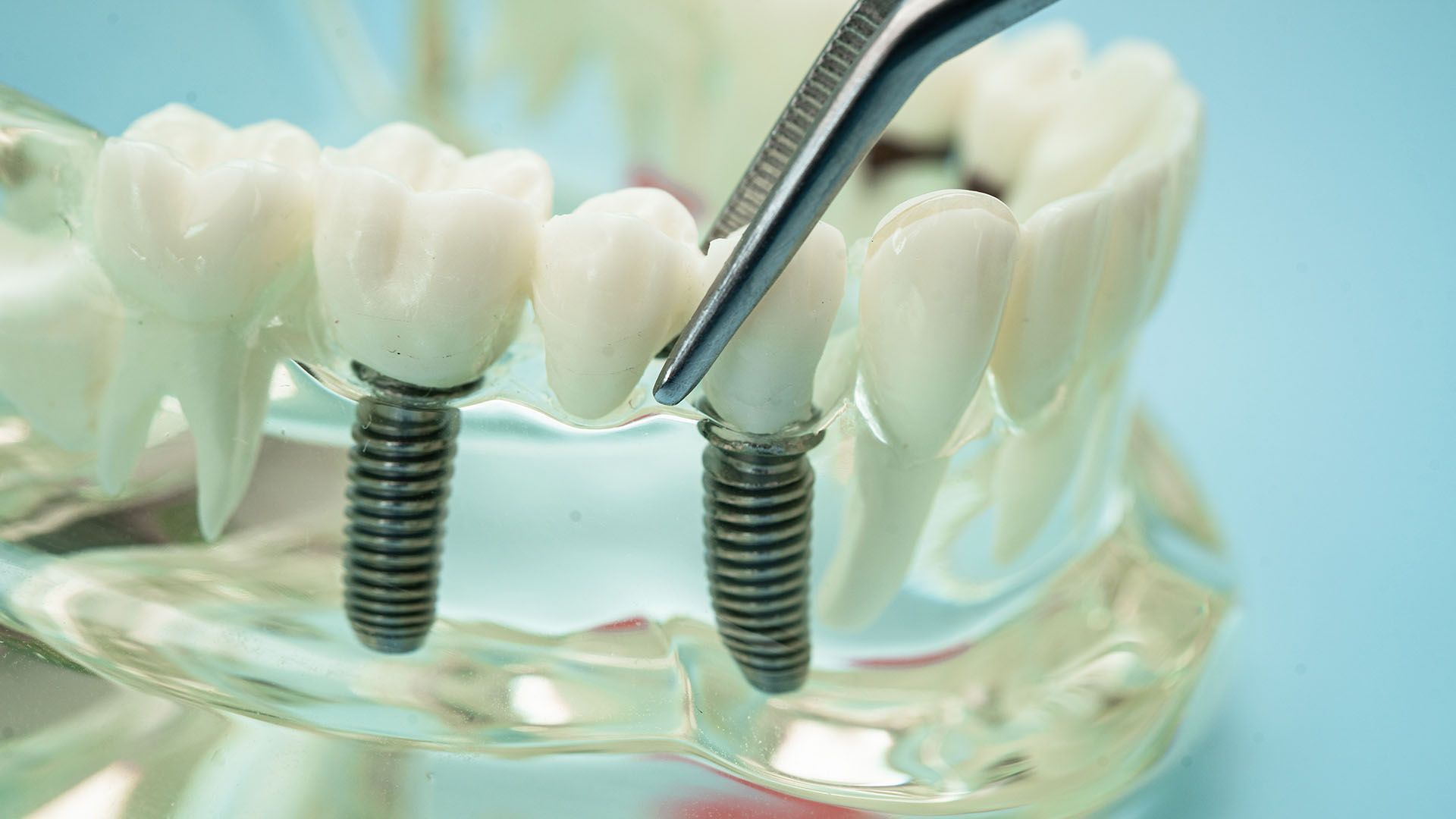How to Put Adhesive on Dentures: A Step-by-Step Guide

At Casas Adobes Dentistry, our dentists fit, adjust, and maintain full and partial dentures every week. We teach patients, right in the chair, exactly how to put adhesive on dentures without the mess, how much to use, and how to keep gums healthy. You'll get clear steps first, then short reasons why they work, written in simple, everyday language.
Clean and dry everything. Use a small amount (tiny dots or short strips, away from edges). Seat the denture, bite down for a few seconds, wait a few minutes before eating or drinking, and remove/soak at night.
Before You Start: Prep for a Secure Hold
A good seal starts with clean, dry surfaces. Think of adhesive like a thin gasket, it works best when the denture and gums are free of moisture and residue.
Clean, Rinse, and Dry Your Dentures
Brush with a soft denture brush and non-abrasive cleanser, rinse thoroughly, then dry completely. Water thins adhesive and leads to oozing.
Rinse Your Mouth and Dry Soft Tissues
Rinse with water to clear food particles. Gently pat gums, palate, and tongue-side tissues dry with a tissue or gauze. A dry surface gives better grip and longer hold.
Check the Fit (Adhesive isn’t a fix for a loose denture)
If your denture rocks, rubs, or pinches, adhesive won't fix the fit. You may need an
adjustment or reline, call us before relying on more products.

Choosing the Right Adhesive
Pick the format that matches your comfort and cleanup preferences. All three can work well when used correctly.
Cream vs. Powder vs. Strips - When to Use Each
- Cream: Most control and a little cushion; easy to fine-tune.
- Powder: Thinner feel, very easy cleanup; sprinkle lightly and tap off excess.
- Strips: Pre-measured and tidy; great for beginners and travel.
Zinc-free and Sensitive-gum Options
If you’ve had irritation, try a zinc-free or sensitive-gum formula. Introduce new products slowly and watch how your tissues respond.
How Long Hold Typically Lasts
Most adhesives are designed for once-a-day use. Expect daytime hold, then remove at night so tissues can rest.
How Much Adhesive to Use
“Small Dots/Short Strips” Rule of Thumb
Start with less than you think. Aim for tiny dots or short, thin strips in the central contact areas, never on the edges.
Avoiding Oozing and Edge Overflow
If you see squeeze-out, you used too much or applied too close to the border. Clean, dry, and try again with less.
Step-by-Step Application (Cream)
Where to Place Dots/Strips on the Upper Denture
Place 3–4 tiny dots or short strips in a gentle “U,” a few millimeters inside the border. Optional: a very small dot toward the palate center, still away from edges.
Where to Place Dots/Strips on the Lower Denture
Use even less: 2–3 tiny dots along the ridge area. Avoid the thin tongue-side edges where overflow happens easily.
Insert, Bite Down, and Hold for Seal
Insert carefully, press evenly, and bite down for 5–10 seconds. If you feel adhesive near cheeks or tongue, remove, clean, dry, and retry with less.
Step-by-Step Application (Powder & Strips)
Powder: Light, Even Sprinkle and Tap Off Excess
Dust a dry base with a very light, even coat. Tap or shake to remove extra powder, insert, then bite gently to set.
Strips: Trim, Moisten, and Position Without Wrinkles
Trim to fit just inside the denture’s borders. Lightly moisten, place flat (no folds), insert, and bite to set.
Special Situations
Partials: Placement and Amount Adjustments
Apply tiny dots only on the pink acrylic base, never on metal clasps. Start minimal and adjust slowly.
Dry Mouth (Xerostomia) Tips for Better Retention
Creams usually perform better than powders when saliva is low. Sip water through the day; consider saliva substitutes if recommended.
After Relines or Adjustments: Temporary Adhesive Use
Follow your dentist’s instructions. If the fit feels off, call us first rather than adding more adhesive.
Eating, Drinking, and Daily Use
Wait Time Before the First Sip or Bite
Give adhesive a few minutes to set (about 5 minutes) before eating or drinking. Begin with small bites and chew on both sides for even pressure.
All-Day Comfort Tips and Re-application Guidance
If dentures loosen late in the day, don’t stack new adhesive on old. Remove, clean off residue, dry, and reapply a tiny amount.
Safe Removal and Cleaning
Warm Water Rinse and Gentle Rocking Technique
Rinse with warm water and use a gentle rocking motion to break the seal, no prying tools.
Removing Residue from Dentures (Soft Brush) and Gums
Brush the denture and your gums with a soft-bristled brush and non-abrasive cleanser. Avoid swallowing any leftover adhesive.
Overnight Care: Soaking and Letting Tissues Rest
Soak dentures overnight in a fresh solution. Give your tissues time to rest and recover daily.
Troubleshooting & When to Call Your Dentist
Common Mistakes (Too Much, Too Close to Edges, Wet Base)
- Too much product →
oozing and bad taste
- Adhesive near borders → leaks and sore spots
- Wet denture base → weak or patchy hold
Signs Your Denture Needs an Adjustment or Reline
Persistent looseness, rubbing, or food sneaking under despite careful placement means the fit needs attention.
Irritation, Ulcers, or Persistent Looseness
Stop adhesive, switch to a gentle formula if needed, and contact us. A quick adjustment often solves the problem.
Quick Do’s and Don’ts
Do’s for Clean, Dry, Minimal Application
- Clean, rinse, and
dry before every application
- Use
small amounts in precise dots or short strips
- Bite down to set the seal
- Soak overnight; let tissues rest
Don’ts: Swallowing Excess, Using as a Fit Substitute, Sleeping with Adhesive On
- Don’t apply on edges or undercuts
- Don't use adhesive to "fix" a loose denture.
get the fit checked
- Don’t sleep in dentures with adhesive
What to Keep on Hand
Adhesive, Soft Brush, Soaking Solution, Storage Case
Your preferred adhesive (consider zinc-free if sensitive), a soft brush, cleanser tablets, and a ventilated case.
Travel-Day Mini Routine and Refresher Tips
Pack tissues, a small tube or a few strips, and cleanser tabs. If you need a mid-day refresh, clean and dry first, then reapply a tiny amount.
Summary: The Minimal, Clean, Consistent Method
Prep → Tiny Amount → Precise Placement → Firm Bite → Gentle Removal
- Prep: Clean, rinse, and
dry dentures and tissues
- Apply: Tiny dots/short strips
inside borders
- Set: Insert and
bite down 5–10 seconds
- Live your day: Wait a few minutes before eating/drinking; don’t layer over residue
- Finish: Warm rinse, gentle rocking, brush away residue,
soak overnight
Want help choosing between cream, powder, or strips, or dialing in how much denture adhesive to use for your mouth? Schedule a visit with Casas Adobes Dentistry. We'll check your fit, make any needed adjustments, and show you a clean, comfortable routine that lasts all day.

Frequently Asked Questions About Front Tooth Crowns
How long should I wait before eating after applying denture adhesive?
Wait about 5 minutes after applying adhesive before eating or drinking. This gives the adhesive time to set and form a proper seal. When you do start eating, begin with small bites and chew on both sides of your mouth to maintain even pressure and a secure fit.
Can I add more adhesive if my dentures feel loose during the day?
No, never layer new adhesive over old. If your dentures loosen throughout the day, remove them, thoroughly clean off all residue, dry both the denture and your gums, then reapply a small, fresh amount. Stacking adhesive creates an uneven, messy hold and can irritate your gums.
Should I sleep with my dentures and adhesive in?
No, you should remove your dentures every night. Sleeping with dentures prevents your gum tissues from resting and recovering, which can lead to irritation, infection, and bone loss over time. Always remove dentures at night, clean them thoroughly, and soak them in a fresh cleaning solution while giving your mouth a break.
My dentures still feel loose even with adhesive—is this normal?
No, this isn't normal. Adhesive provides temporary hold for well-fitting dentures, but it's not a solution for poor fit. If you're using adhesive correctly and your dentures still rock, slip, or allow food underneath, you likely need a professional adjustment or reline. Contact your dentist rather than using more adhesive to compensate.
How much denture adhesive should I actually use?
Less than you think. For upper dentures, use 3-4 tiny dots or short strips placed in a gentle "U" shape, a few millimeters inside the border. For lower dentures, use even less—just 2-3 small dots along the ridge area. If you see adhesive oozing out when you bite down, you're using too much. Start minimal and only increase if absolutely necessary.







